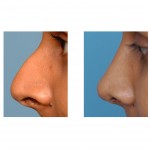
As the cultural makeup of the United States continues to change, people of all ethnic groups represent an increasing number of patients seeking plastic surgery. One of the sought after operations is that of rhinoplasty. Ethnic groups have certain characteristics to their noses (outer appearance) that is quite different than the Caucasian, more ‘Roman’ nose. Therefore, each ethnic group’s nose is addressed individually rather than some standard or ‘cookie cutter’ approach. Most importantly, contrary to the opinions of some, the ethnic patient does not really want to be ‘Westernized’ or look like a Caucasian nose. They prefer to maintain their ethnic look but have a better balance of the nose to the rest of the face.
For these reasons, ethnic rhinoplasty can be more challenging and requires different approached. Unlike Caucasians, every other ethnic group, albeit African-American, Hispanic, or Asian have very thick and oily skin over the nose. This means that a small delicate look to the nose can not be achieved (nor is it desired) but the use of grafts and implants will be well camouflaged. These ethnic rhinoplasty patients almost always have broader and wider noses with a lower nasal bridge and broad nasal tips. Unlike the Caucasian rhinoplasty, these noses usually need to be built up with either cartilage grafts or implants. While implants are easier to use, since they come out-of-the-box so to speak, one must consider the long-term risks of implant infection, changing position, and even possibly eventually coming through the skin in rare cases. Cartilage grafts do not produce as much change and as easily as implants, but have few, if any, problems long-term. The nasal tips often need to narrowed and thinned slightly and maybe given a little upward projection. The ethnic nose’s nostrils are frequently wide or flared and may need to be narrowed. This is done through small incisions just inside the nostrils which leaves no visible scar.
Ethnic rhinoplasty can be very satisfying but it must be approached with an understanding of how the underlying bone and cartilage has created the appearance we see through the skin.
Dr Barry Eppley
Indianapolis, Indianapolis


